What is Acne?
Acne or acne vulgaris is a common skin problem which is often triggered off by oil and dead skin cells which block your skin pores. The severity of acne can vary from mild to severe where hundreds of pimples cover the surface of your skin with no place left even to put a finger on. Upon further extremity, it can also develop into red lumps which can be extremely painful (Cyst).
 Image Source:http://www.timesfull.com
Image Source:http://www.timesfull.com
Acne is a common nightmarish skin condition for teens, which usually gets better after the retreat of teenage years. Some women also complain about acne during the onset of their periods. Having a face full of acne is considered to be a disgrace to beauty in our society. So more and more women are getting conscious about their skin these days. But how you feel about your acne cannot define its severity. Many women have been spotted with severe acne but are not concerned about it while some women lose their calm even on spotting a slight zit on their face.
The difference between Acne and Pimples?
Acne is a broader term which includes blackhead, whiteheads, papules, pustules, zits, cysts, etc. Acne is a term used for skin disorder which involves abnormal sebum secretion, keratinization, and bacteria.
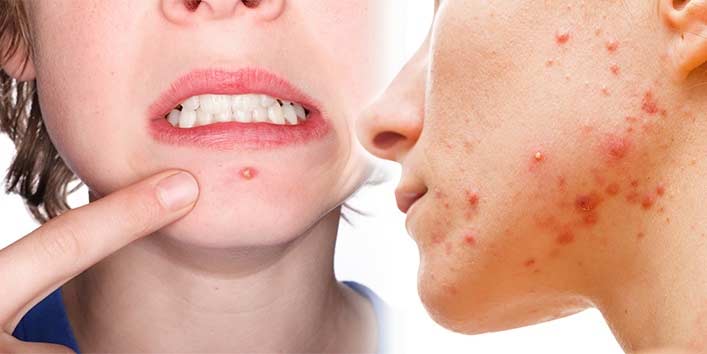
A pimple is a type of acne, which is milder than a fully grown acne. It is a small inflamed skin that is filled with pus. If a pimple persists in larger numbers, than it is listed under acne.
What happens?
During the teen years, both male and females produce male hormone Testosterone more than at any other phase of life. This hormone is responsible for oil glands to produce more oil (sebum). The extra oil pools with the dead skin and blocks the follicles.
If the blocked follicle is close by the skin surface, it will swell outwards and form a whitehead. Bacteria that live on our skin, which are usually harmless, inflame the clogged follicles and cause the adjacent skin to become red and swollen.
Why does it happen?
People who are suffering or have suffered the torture of acne, have this constant question in their mind. Why did it happen? Studies have revealed that four factors are majorly responsible for causing acne and related skin problems. However, the occurrence of acne can’t be solely linked to only these factors. Other aspects are also responsible for acne vulgaris.
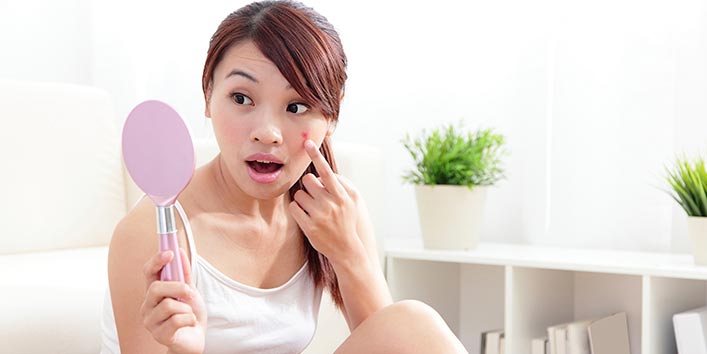 Image Source:http://www.teensincharge.org/
Image Source:http://www.teensincharge.org/
Four major factors that cause acne are:
• Oil production: The reason why you get more acne on your face, neck, back, chest and shoulder is that these regions are more jam-packed with sebaceous glands. Excessively oil producing glands are even more prone to get inflamed and cause acne.
• Dead skin cells: dead skin with the combination of skin oil forms a deadly pimple causing concoction. This mixture emerges from a hair follicle to form a gluey plug.
• Clogged pores: Build-up of oil and dead skin can clog the pores of the skin. The sebum and dead skin cells trapped in the pores gets infected by the bacteria. The bacteria get trapped inside the clogged pore and multiply, feeding on sebum. This triggers off acne.
• Bacteria: mainly, Propionibacterium acnes is the acne causing bacteria that lives on the oily regions of the skin pores. This bacteria can intensify an immune response which causes swelling and redness on the skin with a visible bump. Apart from Propionibacterium acnes, staphylococcus bacterium also contributes to skin problems like acne and zits.
Apart from these basic acne causative agents, some other factors also play their role in causing zits on our face and body. The subsidiary yet substantial factors that contribute to acne are:
1 Genetics:
• Acne is strongly genetic. If you’re having a first degree relative with a chronic problem of acne, then, unfortunately, you susceptible to get inherited skin problems in your genes. Having a relative with acne problem increased your vulnerability by four times.
• Genes do not cause acne directly, but it determines the sensitivity of your skin towards various hormones.
• Genes also influence the inflammatory response of the skin towards bacteria.
• Genes also regulate the production of anti-inflammatory chemicals in your skin.
2.Overdoing the skin care products:
• Skin conscious women often have this ill habit of heaping all the ‘good’ products way too much. Remember, more isn’t always good. Excess of anything will only do you harm.
• The glycolic acid which is also known as AHA is used for its excellent exfoliating properties. IT removes dead skin cells, lighten the hyperpigmentation and enhances your complexion. But overdoing this product can render your skin raw and photosensitive, thus making it more prone to breakouts.
• Salicylic acid is a must to include in the ‘anti-acne regime’ as it mildly regulates the sebum production and even possess antibacterial properties. Who on earth would have thought about it as a causative agent for acne? Overdoing this miracle ingredient can over dry your skin, consequently confusing the sebaceous glands and causing breakouts.
•Vitamin C is a star ingredient and multiple benefits granting. As it is extremely difficult molecule to be evened out, vitamin C masks can leave a damaging effect on the skin if overdone.
•Retinoid: This super-powered youth cream requires utmost care before putting it on your skin. Retinoid trigger off the natural exfoliation process of the skin. Too much application clearly means too much exfoliation. Over exfoliation has never benefitted anyone.
• Too harsh Scrubs: Whenever people hear that exfoliation is good for the skin, they exfoliate their skin in a rather abrasive and traumatic manner. Over exfoliation induces as well as aggravate the existing skin problems.
3.Seasonal change: As soon as the weather starts to dip or shoot up, we begin to notice some changes in our skin appearance and texture. Many a times, our skin greets the skin with an open heart,
but sometimes, it welcomes the season with a brand new zit on the face. The rise in heat or humidity provides a flourishing condition for bacteria. And also, the skin oil production shoots up during the temperature and humidity rise. Changing conditions and oil productions give birth to acne.
4.Medications: Certain drugs like corticosteroids, lithium, anticonvulsants, barbiturates, androgenic steroids, DHEA and medicines containing bromides and iodides can cause acne. Starting or stopping the hormonal birth control pill intake can also initiate acne.
5.Use of inappropriate products: If you’re having a dry skin, but you’re using the oily skin regime, then it is definite that you are getting acne due to overdrying of skin. On the other hand, using products that don’t remove oil while you have oily skin, will only cause accumulation of extra oil on your skin. Sebum filled pores always welcome the bacteria to form a ‘castle’ a.k.a acne.
6.Hormonal changes: Fluctuation of hormones during premenstrual periods or during the pregnancy can cause acne in many women. Increased androgens can put the sebaceous glands in the top gear to let out the river of sebum on the face.
7.Stress: While you are stressing over something, your body is producing more and more androgens, which are nothing more than a menace that induce acne and zits.
8.Unnecessary use of skin tools: Using a washcloth to scrub your skin or putting your hands all over your face and picking up pimples can cause the inflammation of the sebaceous glands.
9.Sun exposure: Tanning deprives the skin of the essential skin oils. It temporarily dries out the skin and also triggers off an injury response which activates the sebaceous glands to produce excess sebum to protect the skin’s surface. And excessive sebum simply implies ACNE!
Acne mapping- What your acne is trying to tell you?
While stressing more about how to cure the acne or how did it get there, we usually overlook the signals that our body is sending out in the form of acne. Sometimes, acne is also an aftermath of an underlying health problem, which will only die out when the problem is fixed. Your acne gives out significant clues about your internal health. The practice of face mapping involves examination of the location of your acne and diagnose the related internal disease. Dr. Shapiro maps out eight most common regions to develop acne, which sends out signal about an underlying health condition:
 Image Source:http://www.holisticvanity.ca/
Image Source:http://www.holisticvanity.ca/
•Forehead: Lack of water and accumulated toxins can cause acne in these regions. The only solution to ease the acne in the forehead region is to drink the lots of water and munch on more fruits and vegetables.
•T-zone: The nose is related to the liver. So acne occurring in this region clearly indicates liver dysfunction
• Around the eyes: The skin in this region is related to kidney health. Acne or dark circles signify poor kidney health or dehydration
• Upper cheeks: The upper cheeks are linked to the respiratory heath. Increased exposure to air pollution or using contaminated phone screens can also cause pimples in this region.
• Lower cheeks: poor dental hygiene and problems in the mouth cause pimples in this region. Avoid sugary drinks and food to eliminate pimples in this zone.
• Nose: painful and bulbous eruptions on the nose warns about poor heart health. Swelling in this zone indicates high blood pressure. Avoid too much salt and energy drinks to bring the blood pressure to normal
• Ears: however it is uncommon to develop pimples in this region, but if so happens, then it clearly indicates poor kidney health. Cut off on the salt and increase the water intake.
• Chin: acne in these regions usually indicates towards poor digestion and problems related to the small intestine
Acne frequency in the US
• However, acne is a worldwide problem and affects everyone equally irrespective of the race, class, gender or geographical condition, still it is the most common skin problem in the United States.
 Image Source:https://wyattemployment.files.wordpress.com/
Image Source:https://wyattemployment.files.wordpress.com/
• It affects almost 40 to 50 million Americans each year.
• 4% of people aged 15-19 visiting doctors are suffering from acne vulgaris.
• Two-thirds of people who visited a doctor for acne problems comprised of women.
• During the age of 20, 50.9 percent of women and 42.5 percent of men reported being subjected to acne.
• 95% of people suffer from acne at some point of their life
• American spends $1.4 million every year on acne products while 40% of acne sufferers still doesn’t do anything about it.
What increases your risk to get an acne?
However, tendencies of getting acne runs in the family. But still, we ourselves can also make way for acne to invade our beautiful skin. The following are the ways through which we’ve been inviting acne troubles in our life:
 Image Source:http://cdn.acneeinstein.com/
Image Source:http://cdn.acneeinstein.com/
• Wearing tight clothes that rub against your skin like shoulder pads or using equipment that somehow touches your skin like a violin or mobile phone also passes off germs to your skin. Helmets, bra straps, and headbands also worsen the problem.
• Making use of skin care products that contains way too many chemicals in it.
• Washing face more than 3 times a day or scrubbing it using an abrasive scrub. Too much hot water can also aggravate the problem
• Going through a lot of stress
• Putting your hands too much on face
• Keeping your hairs hanging on your face
• Taking medicines like corticosteroids, some barbiturates, or lithium.
•Putting up too much on face and hairs.
Acne diagnosis
Diagnosis of the acne is based on history and physical examination. The skin experts examine the affected area closely and ask questions related to your lifestyle and diet to ensure a proper acne diagnosis and to rule out other possibilities that cause similar symptoms. The questions include subjects like:
 Image Source:http://www.betaklinik.de/
Image Source:http://www.betaklinik.de/
• Sensitivity of the skin
• Other diseases that increases the vulnerability to get side effects of medicine
• Any previous drug allergy.
• Use of steroids
• Depression or history of depression
• Use of birth control methods likes pills
• Irregular menstrual cycle or past pregnancy
In some cases, the acne mimics the symptoms of other skin conditions like rosacea.
The skin care expert will also determine the severity of acne, ranging from mild to severe.
The three grades of severity are:
• Grade 1 (Mild) – blackheads and whiteheads with just a few papules and pustules
• Grade 2 (moderate) – multiple papules and pustules mostly confined to face.
• Grade 3 (Moderately severe) – a large number of papules and pustules with inflamed nodules. Acne on back and chest also
• Grade 4 (severe) – the large and excessive number of pustules and nodules.
What to do?
Treatment of the acne depends on the severity of the acne. Many a times your doctor will combine various treatments to get the best result. Treatment could include home remedies, medications, over the counter creams and gels. It doesn’t mean that every acne treatment will work for everyone. Each and every individual responds differently to a particular treatment method. Acne doesn’t heal overnight, and using harsh methods to wipe out acne is a felony which every woman is up to.
 Image Source:http://www1.pictures.livingly.com/
Image Source:http://www1.pictures.livingly.com/
• Home Remedies
nstead of bombarding on expensive and harsh acne treatments, it is better to mug up some natural home remedies to get a natural healthy looking skin. There’s no definite cure that can heal acne overnight, but simple and easy natural remedies which are lying doggo in your pantry or refrigerator, can prevent and minimize the problem. Few home remedies that have proven its success in the combating acne, are as follows:
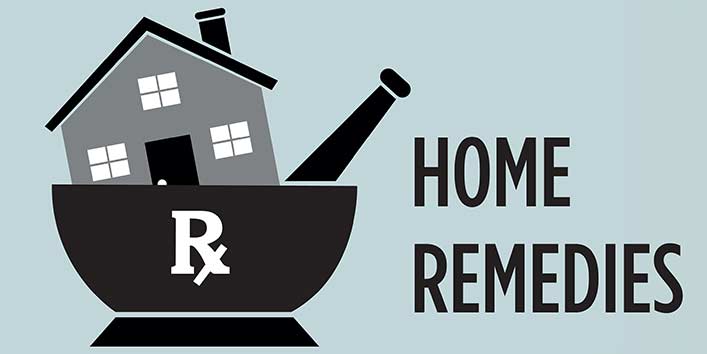 Image Source:http://adhyatmablog.com/
Image Source:http://adhyatmablog.com/
1.The magical ingredient- Apple Cider Vinegar
Apple cider vinegar is a magician when acne treatment is concerned. It destroys the bacteria that cause the trouble of aggravating the clogged pores. Moreover, it is alkaline and hence balances the pH of your skin, which makes it hostile towards bacterial growth. And to crown the benefits, it can also be used as an astringent as it dries up excess oil.
 Image Source:http://manvshair.net
Image Source:http://manvshair.net
Directions:
Wash your face with an antibacterial face wash and pat dry. Take 1 part of vinegar with 3 parts of mineral water. Dip a cotton ball in the solution and apply it straight to your acne and blemishes. Leave it as such for 10-15 minutes. Don’t forget to use a moisturizer afterward as it might cause dryness.
2.Tea Tree Oil:
Most of the acne regime contains tea tree oil, and it makes you wonder whether you need more oil to get rid of acne. Tea tree oil is not like any other oil. It’s like a solvent which cuts off the extra sebum and dead skin cells, which get accumulated on your face, and clean out your pores. Owing to its antibacterial properties, it also slays down acne causing bacteria and checks further outbreaks. Make a note that tea tree oil is only for external use and it should be diluted before use. Plus, it should never be ingested.
 Image Source:http://cdn2.stylecraze.com
Image Source:http://cdn2.stylecraze.com
Directions:
Clean your face thoroughly and pat dry. Make a solution of tea tree oil by taking 1 part of tea tree oil and 9 parts of water. Dab a cotton swab and apply the solution on the affected area. Apply a light moisturizer after it, as it causes to dry out the skin. In the case of sensitive skin, dilute the oil using Aloe Vera instead of water.
3.Marvels of baking soda
Due to its mild antiseptic properties, it is useful in case of acne remedies. It provides three skin benefits as it wards off bacteria and fungus, dries up excess oil and act as a mild Exfoliator. Thus making your skin soft and beautiful.
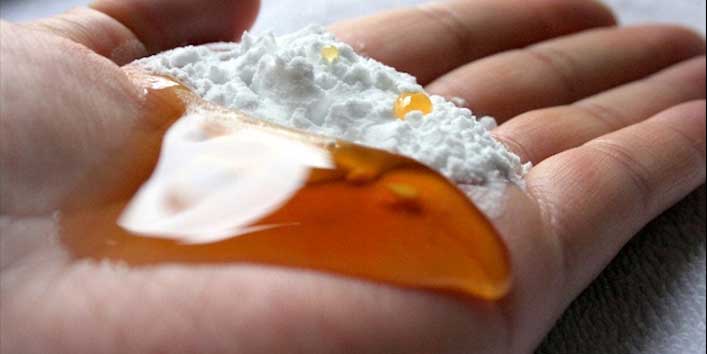 Image Source:http://a2889z1.americdn.com/
Image Source:http://a2889z1.americdn.com/
Directions:
Baking soda can be brought to use in two ways: As a facial scrub and as a facial mask.
To use it as a facial scrub mix half a cup of baking soda with eighth a cup of water. Apply the paste to your face while massaging it in a circular motion. After massaging for 2-3 minutes, wash your face thoroughly with warm water. Pat dry and do not forget to apply moisturizer after that.
4.Amazing Aloe
Aloe Vera is known for its excellent soothing properties and it can heal and fight infection. It is also acknowledged for lightening the scars. For its super beneficiary properties, it has been called names like ‘wand of heaven’ and ‘plant of life’. It has been brought to use for many purposes for over 2000 years.
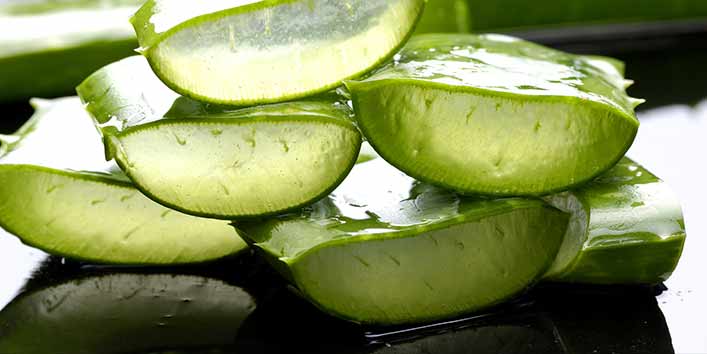 Image Source:http://beautybanter.com
Image Source:http://beautybanter.com
Directions:
Cut off a leave of Aloe Vera if you’re having the plant in the vicinity, or pure Aloe Vera gel is also available in the market. Apply 100% pure Aloe Vera gel on the affected area twice daily. Substantial changes will be seen in just one week.
5.Stream it off
Steam can relieve minor malady of skin, acne being one of them. It helps reduce the swelling and thus the size of acne. It opens up pores, flushing out impurities creeping deep in your skin.
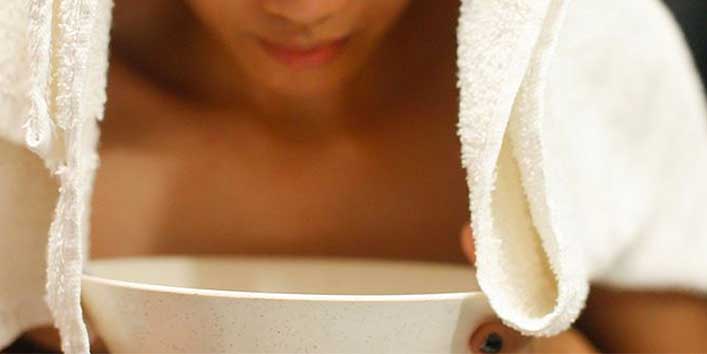 Image Source:http://blog.skinowl.com
Image Source:http://blog.skinowl.com
Directions:
Boil some water and pour it into a wide mouthed bowl and let it cool for a few seconds. After cooling it down a bit, place your face above the bowl and cover your head with a towel to make a steam envelope around your face. After 10-15 minutes, pat dry your face and apply a light moisturizer.
6.Oatmeal at Rescue
Oatmeal is an unmatched ingredient which can be used internally as well externally. If you use soaked oats on your face as a mask, it can reduce the inflammation and redness of the acne. Adding honey can be a cherry on the cake. Honey owns exceptional antibacterial properties and thus combats a pimple causing bacteria and checks the further blowout of acne.
 Image Suorce:http://s3.amazonaws.com/
Image Suorce:http://s3.amazonaws.com/
Directions:
Whip up some oatmeal by following the directions on the box. Add two tablespoons of honey to it. Let the mixture come down to the room temperature. Apply on your face and leave it for 20-30 minutes. When it gets hard to wash it off with warm water.
7.Potato pulp
Potato with excellent bleaching property can also be used to treat acne. As potatoes are packed with potassium, sulfur, phosphorus and chloride, it helps reduce the blemishes. It is also an anti-oxidant which nourishes your skin and ensures a healthy glow.
 Image Source:http://fitnessandgrace.com/
Image Source:http://fitnessandgrace.com/
Directions:
Wash your face and pat it semi-dry. Grate one raw potato and rub the pulp along with the juice on your face in circular motion. Leave it as such for 15-20 minutes and then rinse off completely with water.
8.Green Tea
Studies have been made to show that green tea has an evident effect on easing the acne problem. Green tea is blessed with an antioxidant called epigallocatechin-3-gallate or EGCG, which has shown to reduce inflammation and bacterial growth on the skin. You can use it topically apart from having a cup or two to detoxify yourself internally.
 Image Source:http://www.addisonmagazine.com
Image Source:http://www.addisonmagazine.com
9.Chamomile
Chamomile reduces inflammation caused by acne. It eliminates acne by making use of its anxiolytic and antioxidant properties.
 Image Source:http://mayerstudios.com/
Image Source:http://mayerstudios.com/
Directions:
Brew some chamomile tea in a pot of boiling water. Let it cool down for a few minutes. Store the contents in a spray bottle. Use a cotton ball to swab the solution on the affected area or spritz it directly on your face.
10.Witch Hazel
Witch hazel has natural drying and antiseptic properties. It cleans and refreshes the skin naturally. Moreover, witch hazel is easily available and a cheap remedy for acne.
 Image Source:https://chicgeek123.files.wordpress.com/
Image Source:https://chicgeek123.files.wordpress.com/
Directions:
Witch hazel toner are available in the market. But if you want to make use of a more natural form of witch hazel, you can purchase 100% pure and alcohol-free witch hazel to get its benefits. Dab some witch hazel on a cotton swab and put it directly on your face. It cleans off the dirt and impurities, which cleanser usually fails to eliminate.
• Medications
If the home remedies don’t work significantly for you after a few weeks, then you can switch over to other acne treatments like over the counter preparations or prescription medicines. Other treatments you can opt for if the home remedies failed to do any wonder, are following:
 Image Source:http://cdn2.hubspot.net
Image Source:http://cdn2.hubspot.net
1. Topical Benzoyl Peroxide:
• It is available in the market in the form of a cream, gel or lotion, which can be applied directly to the skin.
• It is a low-cost product which can be used for treating mild acne.
• Common side effect includes dryness, scaling tingling, and stinging.
• Takes up to 6 weeks to show considerable results.
2. Topical Salicylic Acid:
• It is used to treat mild acne
• It is a type of beta hydroxyl acid, which is known for its peeling properties.
• It shells of the dead skin and unclog the pores
• Main side effect includes dryness and increased sensitivity towards the sun.
3. Retinoid:
• It averts the blocking of the pores
• Retinoids are derived from vitamin A
• It has an anti-inflammatory effect on your skin
• Common forms include Retin-A, Retin-A Micro, and Renova.
• Side effects include dryness, scaling, burning, and increased sensitivity to sunlight
4. Topical Azelaic Acid:
• It kills the bacteria that inhabit the open pores of the skin
• It breaks down the keratin which clogs the pores
• Starts to show its result in at least 4 weeks
• Side effects include dryness, peeling, burning, irritation and itching
5. Topical Antibiotics
• Used in combination with retinoid or benzoyl peroxide to curb off the bacterial growth
• Most common antibiotics are clindamycin and erythromycin
• Available in the form of gel or lotion.
• The only side effect is that it irritates the skin where it is applied
6. Topical Sulfa Antibiotics
• It is the oldest antibiotics, which are being used to treat acne
• Available in the form of Klaron and Sulfacet-R
• Applied twice daily as a skin lotion
• No side effect, though might cause an allergic reaction in some.
7. Oral Antibiotics
• It is used for more serious acne
• It controls the bacteria Propionibacterium acnes, which is responsible for causing acne.
• Common antibiotics used are doxycycline, tetracycline, and minocycline.
• Takes 8 weeks to show substantial results
• Possible side effects are nausea, sensitivity to sun, light-headedness and headache
8. Isotretinoin
• It is a derivative of vitamin A.
• It subdues acne and is used for treating severe acne.
• It shrinks the glands that cause oily skin in you
• Side effects are severe, including birth defects and liver damage
9. Birth Control Pills
• Birth control pills are effective acne treatment in young girls
• It regulates hormones that cause your skin to be oily
• Not recommended for those who are having a migraine or any blood clotting disorder
Acne treatment in homeopathy
Acne is a severe skin disorder caused by multiple factors such as hormones, food, climate, irregular lifestyle and stress. Depending on the root causes and factors that led to the problem, the homeopathic medicines are prescribed. Following are the common homeopathic medicines that can be employed for treating acne.
 Image Source:http://www.homeopathicremediesblog.com/w
Image Source:http://www.homeopathicremediesblog.com/w
Calcarea Sulphuricum: If you develop pus on the acne, then this is the correct medicine for you. This medicine is used by people who are less resistant to heat than cold. The acne may be outsized, reddened, and sore with a tendency to get blemishes. It ranks among one the 12 remedies used as a tissue remedy in homeopathy as well as biochemistry.
Silica: It is a wonder drug which is derived from sand. The metal Silica (Si) works on the immune system and hormone by reducing the tendency to grow acne with pus formation, after several doses. If you’re sensitive to cold air, breeze, and cold water, then your skin specialist can prescribe you this medicine.
Dulcamara: This medicine derived from a plant peg away acne and the marks left thereafter. This medicine is prescribed to those whose face may be full of acne and allergic rashes. When climate changes from hot to humid, and you develop acne, then you have to go for Dulcamara.
Natrum Muriaticum: Surprisingly, this medicine is derived from the simplest of the ingredients found in our pantry, common salt. Though it is processed homeopathically through potentization. It is used as a remedy for multiple cases of acne. Acne caused by hormonal disturbances such as PCOS or menstrual irregularities can be handled with Natrum Muriaticum. If you have an oily and bit hairy face, hypertrophied acne, scars, then you might benefit from this medicine.
Pulsatilla: One who’s suffering from acne due to consumption of rich food can be benefitted from this medicine. Pulsatilla is also used by girls who have menstrual irregularities. If you are sensitive to heat, then you may ask your skin expert you to prescribe you this medicine.
Hepar Sulphur: This medicine can be brought to use if you’re suffering from painful eruptions and more boils or abscess. Hepar Sulphur is so far the best medicine used to treat acne.
Silicea: It is commonly used for treating cystic acne. It has been said to give good results on those who are suffering from cystic acne. It is also used for treating scars left by an acne.
Tarentula Cubensis: It is used for treating cystic acne that tends to become larger and eventually become a cyst. These boils are usually accompanied by the stinging type of pain. The tarantula is used for the acne which is purplish in its look.
Calcarea Flour: This homeopathic medicine is used for treating cystic acne that is hardened by the accumulation of pus over it. The skin shows a white look over it. It is used mostly for the cystic acne which is surrounded by a purplish hardened mass around it.
It is better to go for homeopathic treatment rather than allopathic medications because homeopathy has several advantages over allopathy.
Few reasons to convince you to opt for homeopathic treatment for your acne are:
• Suppress the tendency to get acne
• Tackle the causal hormonal disturbance which is responsible for your vulnerability to getting acne
• Cuts off the excessive oil from the skin
• Treats the acne directly
• Curbs infection
• Keep a check on scar formation
• Put a control on hyperpigmentation the following acne
• Reduce the tendency to develop scars after getting an acne
How to prevent getting acne?
Preventing acne is better than finding a cure for the existing ones. There is no cure to acne, but there are certainly some methods to keep them off the nook. Here are few ways through which you can keep ACNE at an arm’s length:
 Image Source:http://sleep-centre.ca
Image Source:http://sleep-centre.ca
1.Keep your face clean: whether or not you’re having acne, cleaning your face two times a day is necessary. Washing more than twice is not required, it may do more harm than good. Use a mild facial cleanser instead of harsh scented ones.
2.Moisturize well: warding off all the oils will do no good. Moisturizing is essential no matter how oily your skin might be. Get a fragrance free noncomedogenic moisturizer, as it doesn’t cause or aggravate the acne.
3.Keep the makeup off for a few days: avoid wearing foundation during breakouts. Even if you have to wear makeup, make sure that you don’t let the makeup stay for more than 6-8 hours. Do not sleep with your makeup on. That’s the worst you can do for your skin.
4.Be careful about hair products: be very careful about what products you’re putting in your hairs. Some shampoos and conditioner which contains strong fragrance and added chemicals can come down to your face and cause clogged pores. Moreover, the dirty hairs can add oil to your face, which will subsequently clog your pores and cause acne.
5.Keep your hands off your face: touching your face continuously can transfer bacteria from your hands to your face. You won’t like to worsen your skin, do you? Never pick and pop pimples. It can only give temporary respite from the ugly looking eruption, but the zit will reemerge worse than before.
6.Avoid the exposure to sun: sun’s harmful UV rays can cause more inflammation of the existing acne. If you’re already taking some topical remedy to treat acne then chances are that your skin has already developed sensitivity towards sunlight. In the case of emergency, and you need to step out in the sun, it’s better to protect your skin wearing an SPF 20 sunscreen. Don’t forget to look at the non-comedogenic label on your sunscreen’s tube.
7.Add fuel to your skin: experts say that eating healthy can be clearly seen as a healthy glow on your face. Add more and more fresh fruits and vegetable to your diet.
8.Sweat out the impurities: Regular exercise is beneficial for your body as well as your skin. Working out produces excessive sweat, which clears and unclog the pores of your skin. Take a shower immediately after you work out.
9.Keep off the stress: no point of stressing over appearance again and again. IT is impossible to cure acne with a blink of an eye. It’s better to be patient and persistent on your efforts to cure acne.
10.Change pillow cover frequently: It will cut down your expenses on the expensive anti-acne creams. All the sweat and dirt gets transferred from the face to pillow covers and causes your skin to break out more. If you’re not washing your face frequently, you’re planting your face on all the dirt and bacteria that has been collected on a pillow for long.
Acne scar removal
Even after the acne has got cured, still it reminds us of its existence camouflaged as acne scars. Setting free of scars is even tougher than it seems to. Treatments and medications can heal a pimple within a month, but pimple scars are stubborn as it doesn’t go off easily. Through regular attention and care, acne scars can be lightened and can also be put to an end to bring out your natural glowing skin.
Image Source:http://www.mi-skin.com/
You can turn to your kitchen for a helping hand to treat the bull-headed acne marks. Some of the following natural ingredients can be brought to use to get rid of acne marks:
1.Lemon Juice
It is a natural bleach with vitamin C to restore collagen. It fades away the speckles and lighten the acne scars. Apart from this, it also reduces the redness of the growing acne.
 Image Source:https://andreadrugay.files.wordpress.com
Image Source:https://andreadrugay.files.wordpress.com
Directions:
• Squeeze out a fresh lemon and apply the juice evenly on your scars using your fingers or a cotton ball. Let it be there for 10 minutes and wash it off with lukewarm water. Do it every day for two or three weeks. In the case of sensitive skin, add some honey to avoid any burning sensation caused by acids in the lemon juice.
• Another method of bringing a lemon to your rescue is mix lemon with equal parts of rose water. Apply this mixture on your scars.
• In the case of dry skin, mix lemon juice with a teaspoon of vitamin E oil and apply the mixture on your scars. Vitamin E is a good soothing liquid and it also enhances the texture of your skin.
• You can also make a lemon mask using lemon juice, honey, almond oil and milk. Mix all the ingredients thoroughly and apply on the scars daily for about 10 days.
• Please make a note, don’t step out in the sun after applying lemon juice.
2.Honey
Honey along with lemon juice also has excellent antioxidant properties and helps reduce scar visibly.
 Image Source:http://sustainablepulse.com
Image Source:http://sustainablepulse.com
Directions:
• Apply honey on the scars before sleeping and wash it off in the morning.
• Make a concoction of honey and oatmeal, and apply this mixture on pimple scars. Leave it as such for 15-20 minutes and then wash it off.
• Add half a teaspoon of cinnamon powder to one tablespoon of honey and apply on scars. After an hour, wash it off with lukewarm water.
• Mix honey with aspirin to make a consistent paste and apply this paste on your scar evenly. Leave for 15 minutes and then wash it off.
3.Aloe Vera
This wonder herb not only soothes existing acne but is also known for reducing scars. It also regenerates the damaged tissues and boost up the restorative process.
 Image Source:https://imarcgroup.files.wordpress.com
Image Source:https://imarcgroup.files.wordpress.com
Directions:
• Scrape off an Aloe leaf directly from the plant and take out the gelatinous portion. Take this gel and apply it on your scars. Leave it there for an hour and then rinse it off.
• To see an immediate result, apply it as many times as you can. It has no side effect.
4.Olive Oil
It is the most skin friendly oil because it contains a complete lot of vitamins (A, D, E, C, B1, and B2), irons and antioxidants. The anti-inflammatory properties of olive oil also help reduce scars.
 Image Source:http://i.huffpost.com/
Image Source:http://i.huffpost.com/
Directions:
• Take a little amount of olive oil and massage it gently over your scars.
• Massage for a few minutes until you start to feel that the oil has been absorbed by the skin.
• Take a clean face towel and dip it into warm water
• Squeeze the water out and put the towel on your marks.
• Wipe away the excess oil with a towel.
• After few minutes, wash your face with a mild cleanser.
5.Baking Soda
It is another popular and tested remedy to remove the stubborn acne scars. It scrapes off the dead skin cells through its gentle exfoliating property.
 Image Source:http://cx.aos.ask.com/
Image Source:http://cx.aos.ask.com/
Directions:
• Take nearly 2 teaspoons of baking soda in a clean bowl and add clean
water to it to make a consistent toothpaste-like paste.
• Massage this paste gently on your face in the circular motion
• After massaging for 2-3 minutes, leave the paste to dry off.
• Wash your face with warm water.
• Don’t forget to put some moisturizer as baking soda often dries up the skin
6.Raw potato
Potato is known for its excellent bleaching property, so no wonder why it is being used since ages for lightening up the scars and also to bleach the facial hairs.
 Image Source:http://www.azminanutrition.com
Image Source:http://www.azminanutrition.com
Directions:
• Cut a potato into round slices.
• Take each slice and rub gently all over your face. Focusing more on your scars.
• Repeat the process for 15-20 minutes
• Leave your face, untouched to let the juice get absorbed by your skin
• Wash your face with lukewarm water
• Apply a moisturizer afterward.
7.Raw tomato
 Image Source:https://katydid972.files.wordpress.com/
Image Source:https://katydid972.files.wordpress.com/
Directions:
• Take ripe red tomatoes and cut it into half
• Mash the pieces to let out all the juices of the fruit.
• Apply this juice using a cotton ball on your face.
• Leave it for 15-20 minutes
• Wash off your face using normal water
8.Tea tree oil
Tea tree oil is the favorite ingredient for all those who have or who are suffering from acne problems. It is well-known for its antiseptic, antibacterial, and antifungal properties. This oil is used to treat the hypertrophic scars which are usually bulged out and red. The oil is also hydrating, it also retains moisture and gradually diminishes the scar.
 Image Source:http://www.dollzindubai.com
Image Source:http://www.dollzindubai.com
Direction:
• Mix some tea tree oil in water
• Dip a cotton ball into the solution
• And apply this solution to your face.
• Repeat at least twice or thrice a day.
• Don’t use tea tree oil undiluted
9.Apple cider vinegar
It is used as an astringent and a natural disinfectant as well. Apple cider vinegar is a scar removal remedy also due to the fact that vinegar wipes off the dead skin cells. It fades the acne scars to a great extent.
 Image Source:http://thenakedlabel.com/
Image Source:http://thenakedlabel.com/
Direction:
• Mix apple cider vinegar with water.
• Dip the cotton ball in the solution
• Dab the cotton soaked in the solution on your acne scars.
• Leave it there for a few minutes
• Wash it off with cold water.
• Apple cider vinegar can also be used in combination with honey. Mix equal parts of vinegar and honey to make a solution. Apply this solution on your scars and wash it off after a few minutes.
10.Vitamin E oil
Vitamin E has long been used to treat skin problem as it is said to be the most vital nutrients for restoring regenerative properties of skin. A skin which is deficient of vitamin E dries out and is prone to break out even more.
 Image Source:https://i.ytimg.com
Image Source:https://i.ytimg.com
Directions:
• Wash your face and take steam to clean out your pore for any remaining impurities.
• Take a few drops of vitamin E oil and spread it even on your palm. If you don’t have vitamin E oil, you can also use capsule. Just puncture the capsule and extrude the oil out of it.
• Apply the oil evenly on your face while massaging it in a circular motion.
• Leave it there for about 15 minutes.
• Wash your face with a mild cleanser.
Celebrities with acne problems
If you’re constantly looking at the mirror and brooding over your freckled face, then there is a piece of information that might bring some respite to you. Our celebrities are not as perfect as they seem to be. The truth is, they’re human! And just like any other human being, just like you, they too have acne problems. Check this list of 15 celebrities, who have been dealing with acne problems since their adulthood.


















